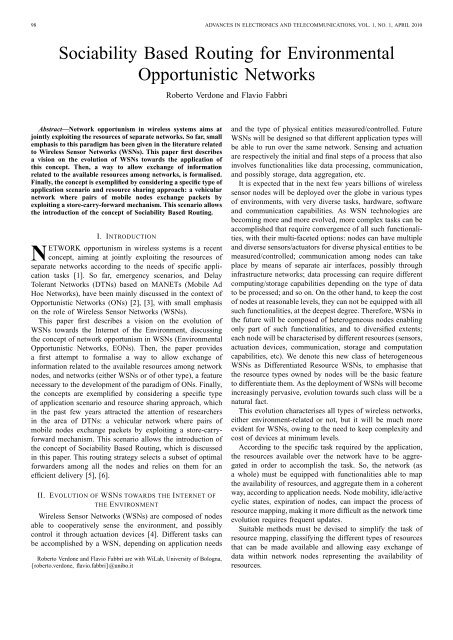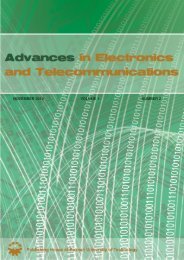channel - Advances in Electronics and Telecommunications
channel - Advances in Electronics and Telecommunications
channel - Advances in Electronics and Telecommunications
Create successful ePaper yourself
Turn your PDF publications into a flip-book with our unique Google optimized e-Paper software.
98 ADVANCES IN ELECTRONICS AND TELECOMMUNICATIONS, VOL. 1, NO. 1, APRIL 2010<br />
Sociability Based Rout<strong>in</strong>g for Environmental<br />
Opportunistic Networks<br />
Abstract—Network opportunism <strong>in</strong> wireless systems aims at<br />
jo<strong>in</strong>tly exploit<strong>in</strong>g the resources of separate networks. So far, small<br />
emphasis to this paradigm has been given <strong>in</strong> the literature related<br />
to Wireless Sensor Networks (WSNs). This paper first describes<br />
a vision on the evolution of WSNs towards the application of<br />
this concept. Then, a way to allow exchange of <strong>in</strong>formation<br />
related to the available resources among networks, is formalised.<br />
F<strong>in</strong>ally, the concept is exemplified by consider<strong>in</strong>g a specific type of<br />
application scenario <strong>and</strong> resource shar<strong>in</strong>g approach: a vehicular<br />
network where pairs of mobile nodes exchange packets by<br />
exploit<strong>in</strong>g a store-carry-forward mechanism. This scenario allows<br />
the <strong>in</strong>troduction of the concept of Sociability Based Rout<strong>in</strong>g.<br />
I. INTRODUCTION<br />
NETWORK opportunism <strong>in</strong> wireless systems is a recent<br />
concept, aim<strong>in</strong>g at jo<strong>in</strong>tly exploit<strong>in</strong>g the resources of<br />
separate networks accord<strong>in</strong>g to the needs of specific application<br />
tasks [1]. So far, emergency scenarios, <strong>and</strong> Delay<br />
Tolerant Networks (DTNs) based on MANETs (Mobile Ad<br />
Hoc Networks), have been ma<strong>in</strong>ly discussed <strong>in</strong> the context of<br />
Opportunistic Networks (ONs) [2], [3], with small emphasis<br />
on the role of Wireless Sensor Networks (WSNs).<br />
This paper first describes a vision on the evolution of<br />
WSNs towards the Internet of the Environment, discuss<strong>in</strong>g<br />
the concept of network opportunism <strong>in</strong> WSNs (Environmental<br />
Opportunistic Networks, EONs). Then, the paper provides<br />
a first attempt to formalise a way to allow exchange of<br />
<strong>in</strong>formation related to the available resources among network<br />
nodes, <strong>and</strong> networks (either WSNs or of other type), a feature<br />
necessary to the development of the paradigm of ONs. F<strong>in</strong>ally,<br />
the concepts are exemplified by consider<strong>in</strong>g a specific type<br />
of application scenario <strong>and</strong> resource shar<strong>in</strong>g approach, which<br />
<strong>in</strong> the past few years attracted the attention of researchers<br />
<strong>in</strong> the area of DTNs: a vehicular network where pairs of<br />
mobile nodes exchange packets by exploit<strong>in</strong>g a store-carryforward<br />
mechanism. This scenario allows the <strong>in</strong>troduction of<br />
the concept of Sociability Based Rout<strong>in</strong>g, which is discussed<br />
<strong>in</strong> this paper. This rout<strong>in</strong>g strategy selects a subset of optimal<br />
forwarders among all the nodes <strong>and</strong> relies on them for an<br />
efficient delivery [5], [6].<br />
II. EVOLUTION OF WSNS TOWARDS THE INTERNET OF<br />
THE ENVIRONMENT<br />
Wireless Sensor Networks (WSNs) are composed of nodes<br />
able to cooperatively sense the environment, <strong>and</strong> possibly<br />
control it through actuation devices [4]. Different tasks can<br />
be accomplished by a WSN, depend<strong>in</strong>g on application needs<br />
Roberto Verdone <strong>and</strong> Flavio Fabbri are with WiLab, University of Bologna,<br />
{roberto.verdone, flavio.fabbri}@unibo.it<br />
Roberto Verdone <strong>and</strong> Flavio Fabbri<br />
<strong>and</strong> the type of physical entities measured/controlled. Future<br />
WSNs will be designed so that different application types will<br />
be able to run over the same network. Sens<strong>in</strong>g <strong>and</strong> actuation<br />
are respectively the <strong>in</strong>itial <strong>and</strong> f<strong>in</strong>al steps of a process that also<br />
<strong>in</strong>volves functionalities like data process<strong>in</strong>g, communication,<br />
<strong>and</strong> possibly storage, data aggregation, etc.<br />
It is expected that <strong>in</strong> the next few years billions of wireless<br />
sensor nodes will be deployed over the globe <strong>in</strong> various types<br />
of environments, with very diverse tasks, hardware, software<br />
<strong>and</strong> communication capabilities. As WSN technologies are<br />
becom<strong>in</strong>g more <strong>and</strong> more evolved, more complex tasks can be<br />
accomplished that require convergence of all such functionalities,<br />
with their multi-faceted options: nodes can have multiple<br />
<strong>and</strong> diverse sensors/actuators for diverse physical entities to be<br />
measured/controlled; communication among nodes can take<br />
place by means of separate air <strong>in</strong>terfaces, possibly through<br />
<strong>in</strong>frastructure networks; data process<strong>in</strong>g can require different<br />
comput<strong>in</strong>g/storage capabilities depend<strong>in</strong>g on the type of data<br />
to be processed; <strong>and</strong> so on. On the other h<strong>and</strong>, to keep the cost<br />
of nodes at reasonable levels, they can not be equipped with all<br />
such functionalities, at the deepest degree. Therefore, WSNs <strong>in</strong><br />
the future will be composed of heterogeneous nodes enabl<strong>in</strong>g<br />
only part of such functionalities, <strong>and</strong> to diversified extents;<br />
each node will be characterised by different resources (sensors,<br />
actuation devices, communication, storage <strong>and</strong> computation<br />
capabilities, etc). We denote this new class of heterogeneous<br />
WSNs as Differentiated Resource WSNs, to emphasise that<br />
the resource types owned by nodes will be the basic feature<br />
to differentiate them. As the deployment of WSNs will become<br />
<strong>in</strong>creas<strong>in</strong>gly pervasive, evolution towards such class will be a<br />
natural fact.<br />
This evolution characterises all types of wireless networks,<br />
either environment-related or not, but it will be much more<br />
evident for WSNs, ow<strong>in</strong>g to the need to keep complexity <strong>and</strong><br />
cost of devices at m<strong>in</strong>imum levels.<br />
Accord<strong>in</strong>g to the specific task required by the application,<br />
the resources available over the network have to be aggregated<br />
<strong>in</strong> order to accomplish the task. So, the network (as<br />
a whole) must be equipped with functionalities able to map<br />
the availability of resources, <strong>and</strong> aggregate them <strong>in</strong> a coherent<br />
way, accord<strong>in</strong>g to application needs. Node mobility, idle/active<br />
cyclic states, expiration of nodes, can impact the process of<br />
resource mapp<strong>in</strong>g, mak<strong>in</strong>g it more difficult as the network time<br />
evolution requires frequent updates.<br />
Suitable methods must be devised to simplify the task of<br />
resource mapp<strong>in</strong>g, classify<strong>in</strong>g the different types of resources<br />
that can be made available <strong>and</strong> allow<strong>in</strong>g easy exchange of<br />
data with<strong>in</strong> network nodes represent<strong>in</strong>g the availability of<br />
resources.







